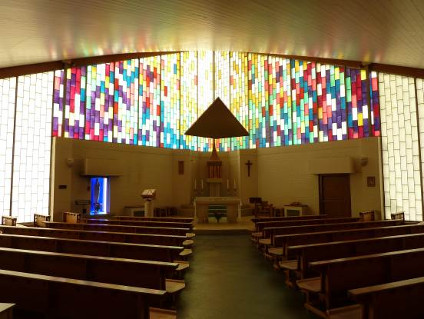By Harry Mottram: A second and rare example of 1960s design is set to disappear if an application to demolish it is agreed with planners – following an application to knock down Beazer House on Lower Bristol Road. This time it is the Catholic Church of the Good Shepherd in Batheaston built in 1967 and a classic example of mid 20th century brutalist design with its striking angular geometries and use of functional concrete as a material. Other local examples include Clifton Cathedral – which too has a carpark as part of the layout – a nod to the realities of the 20th century when the car became king.

The church in Batheaston closed during Covid and had has been shuttered for some time – it is located on the steep Brow Hill and Penthouse Hill junction and was one of the first churches in the diocese to be planned according to the new liturgical requirements with a freestanding altar. Designed by Martin Fisher, the church is square on plan, with the altar in the southeast corner. Seating is arranged radially with a capacity of 200 worshipers. A church hall is located under part of the main building making it both functional and economic creating two structures for the price of one.

On the website Taking Stock: the Catholic Churches of England and Wales it notes: “The eastern diagonal half of the roof rises over the sanctuary, while the western half is flat. Most of the walls (apart from the wall facing the street) have small-paned windows, externally covered in polycarbonate sheets. The main entrance is via a small flat-roofed narthex along the northwest wall. An external staircase leads to a door in the southeast wall, while a projection at the south corner contains a confessional.” To read the full description that includes the confessional and other details visit https://taking-stock.org.uk/building/batheaston-the-good-shepherd/
Brutalism was about functionality and idealism and was popular in post war Europe and Britain – in part due to its futuristic designs in a complete break with the fussiness of past styles. Today the idea of Brutalism has become unfashionable and is linked to the overuse of concrete often seen in multi-storey carparks and in particular in London’s South Bank Centre. However, every era of design falls out of fashion – just as the Georgian and Victorian periods have done in the past – but are now cherished.
In an email seen by Bath Voice the Bath Preservation Trust have apparently agreed with the destruction of the place of worship saying they have ‘no objection to the demolition of the existing 20th century building,’ and they go on to argue that the site should not then be over developed for housing as it is in a Conservation Area.

For those with some knowledge of the Bible and Christianity, Jesus Christ refers to himself in a number of passages as The Good Shepherd and is often depicted in paintings and illustrations with a lamb. For instance in the Gospel of John, Jesus states “I am the good shepherd” and that ‘ I lay down my life for the sheep.’ Clearly nobody is about to lay down their life in the path of the developers. However it is often worth stepping back for a moment and reflecting whether another piece of the city’s history is about to disappear. As the Twentieth Century Society states in its mission statement about buildings such as the Catholic Church of the Good Shepherd in Batheaston: “Some are iconic, others are little-known gems, but all of them are irreplaceable and many are under threat.”
The counter argument is the city needs more housing and since the application is from the Catholic Church itself they are perhaps best to judge whether the church is no longer needed. Whether the new designs put forward will enhance the area is of course open to opinion – but certainly there is a housing shortage and Batheaston is a very desirable area to live.

Another factor is the decline in church attendance with a drop in those who define themselves as Catholics in England and Wales by around 20% since the 1990s – depending on which figures your accept as accurate. Overall the numbers who attend church are down as well with a high percentage of believers only attending mass occasionally – again depending on which survey you believe. But the decline in attendance is undeniable which leaves the church (along with most denominations) with barely used buildings which are often located in highly desirable places. Hence the decision behind this proposal by the Clifton Diocese.
The planning application was made last year by The Clifton Diocese and is pending. Details at https://www.bathnes.gov.uk/webforms/planning/ and key in the post code of BA1 7EN.
Your views to news@bathvoice.co.uk

Bath Voice Monthly Newspaper is distributed free to thousands of homes and some supermarkets – distributed from the first of the month. Harry Mottram is the News Editor
Email him at news@bathvoice.co.uk Bath website: https://bathvoice.co.uk/news/
Bath Facebook: https://tinyurl.com/bdtf2kep Also on Twitter: https://twitter.com/bath_voice Read the newspaper online at :https://issuu.com/bathvoice To advertise to thousands of Bathonians call Erica on 07402 441485 or email her on erica@bathvoice.co.uk
Harry Mottram is a freelance journalist. Follow him on Facebook, LinkedIn, Twitter, Instagram, YouTube, Pinterest, Telegram, TikTok and Email:harryfmottram@gmail.com
Website:www.harrymottram.co.uk Mobile: 07789 864769

